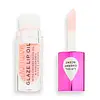What's inside
What's inside
 Key Ingredients
Key Ingredients

 Benefits
Benefits

 Concerns
Concerns

 Ingredients Side-by-side
Ingredients Side-by-side

Ethylhexyl Palmitate
EmollientDiisostearyl Malate
EmollientPolybutene
Tridecyl Trimellitate
EmollientHydrogenated Styrene/Isoprene Copolymer
Phenoxyethanol
PreservativeTocopheryl Acetate
AntioxidantPrunus Avium Seed Oil
EmollientSimmondsia Chinensis Seed Oil
EmollientButyrospermum Parkii Butter
Skin ConditioningRetinyl Palmitate
Skin ConditioningPentaerythrityl Tetra-Di-T-Butyl Hydroxyhydrocinnamate
AntioxidantTrihydroxystearin
Skin ConditioningTocopherol
AntioxidantSodium Hyaluronate
HumectantGlucomannan
Skin ConditioningAroma
Limonene
PerfumingCI 19140
Cosmetic ColorantCI 15850
Cosmetic ColorantEthylhexyl Palmitate, Diisostearyl Malate, Polybutene, Tridecyl Trimellitate, Hydrogenated Styrene/Isoprene Copolymer, Phenoxyethanol, Tocopheryl Acetate, Prunus Avium Seed Oil, Simmondsia Chinensis Seed Oil, Butyrospermum Parkii Butter, Retinyl Palmitate, Pentaerythrityl Tetra-Di-T-Butyl Hydroxyhydrocinnamate, Trihydroxystearin, Tocopherol, Sodium Hyaluronate, Glucomannan, Aroma, Limonene, CI 19140, CI 15850
Polyisobutene
Caprylic/Capric Triglyceride
MaskingParaffinum Liquidum
EmollientSilica Dimethyl Silylate
EmollientDiisopropyl Adipate
EmollientSqualane
EmollientBis-Ethylhexyloxyphenol Methoxyphenyl Triazine
Skin ConditioningButyl Methoxydibenzoylmethane
UV AbsorberEthylhexyl Salicylate
UV AbsorberEthylhexyl Triazone
UV AbsorberOctyldodecanol
EmollientDiethylamino Hydroxybenzoyl Hexyl Benzoate
UV FilterOctocrylene
UV AbsorberButyrospermum Parkii Butter
Skin ConditioningDicaprylyl Carbonate
EmollientGlyceryl Dibehenate
EmollientSynthetic Beeswax
Emulsion StabilisingTribehenin
EmollientGlyceryl Behenate
EmollientBisabolol
MaskingCaprylyl Glycol
EmollientStearalkonium Hectorite
Gel FormingTocopherol
AntioxidantEthylhexyl Palmitate
EmollientPropylene Carbonate
SolventHydrogenated Polydecene
EmollientButylene Glycol
HumectantPentylene Glycol
Skin ConditioningDunaliella Salina Extract
Skin ConditioningSodium Hyaluronate
HumectantPolyisobutene, Caprylic/Capric Triglyceride, Paraffinum Liquidum, Silica Dimethyl Silylate, Diisopropyl Adipate, Squalane, Bis-Ethylhexyloxyphenol Methoxyphenyl Triazine, Butyl Methoxydibenzoylmethane, Ethylhexyl Salicylate, Ethylhexyl Triazone, Octyldodecanol, Diethylamino Hydroxybenzoyl Hexyl Benzoate, Octocrylene, Butyrospermum Parkii Butter, Dicaprylyl Carbonate, Glyceryl Dibehenate, Synthetic Beeswax, Tribehenin, Glyceryl Behenate, Bisabolol, Caprylyl Glycol, Stearalkonium Hectorite, Tocopherol, Ethylhexyl Palmitate, Propylene Carbonate, Hydrogenated Polydecene, Butylene Glycol, Pentylene Glycol, Dunaliella Salina Extract, Sodium Hyaluronate
 Reviews
Reviews

Ingredients Explained
These ingredients are found in both products.
Ingredients higher up in an ingredient list are typically present in a larger amount.
This ingredient is also known as shea butter. It is an effective skin hydrator and emollient.
Emollients help soothe and soften your skin. It does this by creating a protective film on your skin. This barrier helps trap moisture and keeps your skin hydrated. Emollients may be effective at treating dry or itchy skin.
Shea butter is rich in antioxidants. Antioxidants help fight free-radicals, or molecules that may harm the body. It is also full of fatty acids including stearic acid and linoleic acid. These acids help replenish the skin and keep skin moisturized.
While Shea Butter has an SPF rating of about 3-4, it is not a sunscreen replacement.
Shea butter may not be fungal acne safe. We recommend speaking with a professional if you have any concerns.
Learn more about Butyrospermum Parkii ButterEthylhexyl Palmitate, also known as octyl palmitate, is created from 2-ethylhexyl alcohol and palmitic acid. It is a fatty acid ester.
The fatty acid content of Ethylhexyl Palmitate makes it an emollient. Emollients help soften and hydrate your skin by trapping moisture within.
Ethylhexyl Palmitate is also used to help improve the texture of cosmetics. It helps other ingredient dissolve in products and help disperse ingredients more evenly.
You'll likely find this ingredient in sunscreen, as it is often used to mix UV-blocking ingredients such as avobenzone and ethylhexyl triazone.
It can also help stabilize the fragrances in a product as a fragrance fixative.
Ethylhexyl Palmitate can be used to substitute mineral oil.
Due to its high fatty acid content, it may not be fungal-acne safe.
Learn more about Ethylhexyl PalmitateSodium Hyaluronate is hyaluronic acid's salt form. It is commonly derived from the sodium salt of hyaluronic acid.
Like hyaluronic acid, it is great at holding water and acts as a humectant. This makes it a great skin hydrating ingredient.
Sodium Hyaluronate is naturally occurring in our bodies and is mostly found in eye fluid and joints.
These are some other common types of Hyaluronic Acid:
Learn more about Sodium HyaluronateTocopherol (also known as Vitamin E) is a common antioxidant used to help protect the skin from free-radicals and strengthen the skin barrier. It's also fat soluble - this means our skin is great at absorbing it.
Vitamin E also helps keep your natural skin lipids healthy. Your lipid skin barrier naturally consists of lipids, ceramides, and fatty acids. Vitamin E offers extra protection for your skin’s lipid barrier, keeping your skin healthy and nourished.
Another benefit is a bit of UV protection. Vitamin E helps reduce the damage caused by UVB rays. (It should not replace your sunscreen). Combining it with Vitamin C can decrease sunburned cells and hyperpigmentation after UV exposure.
You might have noticed Vitamin E + C often paired together. This is because it is great at stabilizing Vitamin C. Using the two together helps increase the effectiveness of both ingredients.
There are often claims that Vitamin E can reduce/prevent scarring, but these claims haven't been confirmed by scientific research.
Learn more about Tocopherol